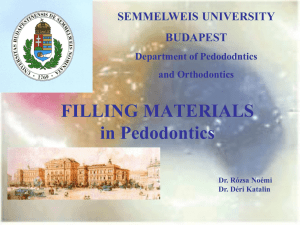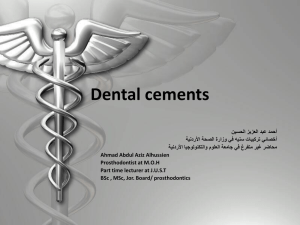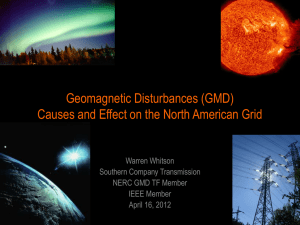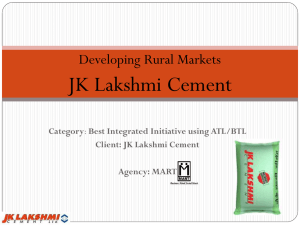glass ionomer cement
advertisement
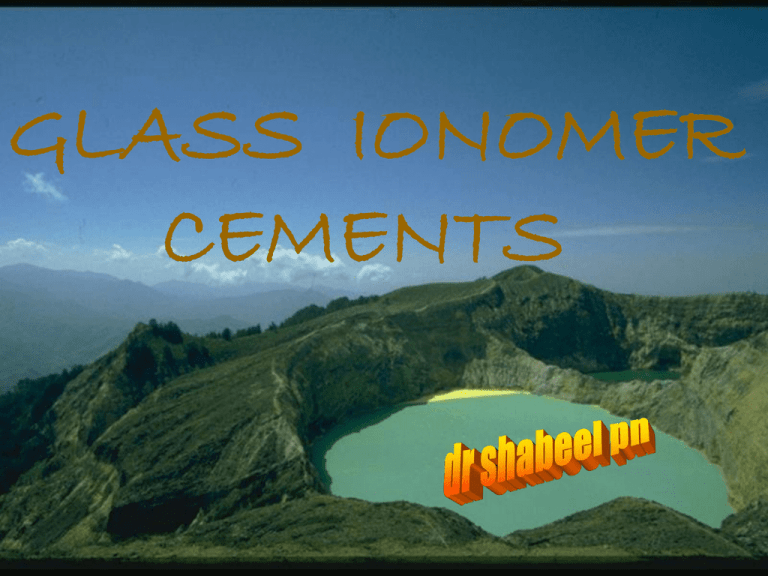
GLASS IONOMER CEMENTS INTRODUCTION GIC is an adhesive tooth coloured restorative material used for eroded areas and now it has been used for other areas also . Salt formed by reaction between poly alkenoic acid and Calcium aluminoflurosilicate glass . HISTORY developed by Wilson & Kent in 1972 . Yogi etal - 1992 – GI cement is used as a sealent for partially erupted permanent molars . Groll etal – 1993 – Recommended light curable glass polyalkeonate for amalgam replacement . Althadaing etal - 1994 – light cured glass ionomer for repairing furcated areas on the pulpal floor . Thevadans etal – 1996 – Mixing of 4 % NaF with GIC. . Historical evolution of GIC Also named as…… polyalkeonates . . ASPA (aluminosilicatepolyacrylic acid ) developed by Wilson etal 1970 . ADVANTAGES Tooth coloured material . It will adhere directly to both enamel and dentine through ion exchange mechanism . Biologically active as it is capable of releasing fluorides , calcium and phosphate . CLASSIFCATION CLASSIFICATION TYPE I - Luting TYPE II – Resoration . TYPE III – Liners and bases . TYPE IV - Pit and fissure sealants . TYPE V – Orthodontic cements . TYPE VI – Core built up. CLASSIFICATION…… • • • • • • • • • TYPE TYPE TYPE TYPE TYPE TYPE TYPE TYPE TYPE I II III IV V VI VII VIII IX - Luting - Restoration - Liners & Bases - Resin modified - Metal modified - Ceromers - Compomers - Geriatric - Pediatric CLASSIFICATION BY G J MOUNT Based on the - water powder ratio. physical properties . clinical application . TYPE I – Luting agents . TYPE II i – Esthetic restoration . TYPE II ii – Non esthetic restoration . TYPE III - Liners and bases . CLASSIFICATION NO:3 TYPE I Conventional TYPE II Restorative Class 1 – esthetic restorative cements . Class 2 – reinforced restorative cements or metal modified glass ionomer . TYPE III Light cured lining glass ionomer cement ( liners and bases ) . TYPE I –CONVENTIONAL GI. Mostly used in cementing , luting , liners and bases . Powder particle size – 15 micron . Thickness of cement film – 2 micron . Thin pulpal dentin is required to be protected with hard Setting Ca ( OH )2 . TYPE II RESTORATIVE GIC Class I esthetic restorative cement Mostly used for anterior restorations Class II reinforced restoration cements Class I reinforced restoration cement ( metal modified , posterior GI) Mostly used for posterior restorations . A ) Amalgam alloys mixed with cements. B ) Cermet ( ceramic metal mixture ) Glass powder is fused and sintered with Ag particles . PROPERTIES Resistance to wear as they are stronger and tougher . Poor esthetics due metallic color Less pulpal irritation . Posses anticariogenic properties TYPE 3 a – Light cured lining glass ionomer cements HEMA ( hydroxy ethyl methacrylate ) added to light component . Reduce shrinkage . To increase strength , powder mixed with alumino – silicate glass. Light cured GIC TYPE 3 b – Light cured glass ionomer cement COMPOSITION POWDER - ion leachable glass . LIQUID - Polyacrylic acid or Polyacrylic acid with HEMA . SETTING REACTION Initial set – polymerization of methacrylate gp Final set – slow acid – base reaction PROPERTIES Reduced translucency . Increased tensile strength Stronger adhesion to teeth surface . Decreased marginal adaption and increased marginal leakage due to polymerization shrinkage . TYPE 4 Hybrid resin modified G I Used as restorative filling material. HEMA added to liquid component - bonding. Have higher resistance to wear & tear. Used in class 1,2,5 filling with conservative cavity preparation. Avoid cavities in deciduous teeth. Light cured GIC AVAILABLE AS… Powder – liquid system . Pre – proportionate capsule . Light cure system . Dual cure system (chemical +light) . Luting ,restorative & root canal cements Cement dispensing system COMPOSITION POWDER acid soluble calcium fluoro aluminosilicate glass SiO2 -35-40% Al2O3 -20-25% AlF3 -1.5-3 % CaF2 -15-20 % NaF -4-10 % AlPO4 -1-15 % Fluoride component - ceramic flux . Lanthanum , strontium,barium , ZnOradiopacity . Fine colloidal Ag and amalgam enhance the properties. LIQUID 40 -50% acidic solution…… Poly acrylic acid . Tartaric acid . Water. Poly acrylic acid – very viscous Tendancy to gelation . Poly acrylic acid co-polymerized with itaconic acid maleic acid . Increases the reactivity of liquid . Decreases the viscosity . Decreases the tendency to gelation . TARTARIC ACID Improve the handling character . Decreases the viscosity . Increases the working time . Decreases the setting time . WATER Most important constituents . Too much of water- weak cement . Too little water – dehydration . SETTING REACTION The liquid acid may be freeze dried and combined with powder [ to have better shelf life and lower viscosity which are important characteristics for luting agents . Mix can be done on a disposable moisture resistant paper pad or a glass slab . A plastic spatula is preferred to a metal one to minimize contamination of the mix from eroded metal . Large increment of powder are rapidly incorporated into the liquid and mixing should be completed within 40 sec Working time – short , not more than 3 min from start of mixing . SETTING REACTION Powder and liquid mixed together Acid attacks the glass particles . Na,Ca,Al ,F ions are leached into the aquous solution Ca poly salts in the beginning and later Al – poly salts . Two salts cross links to form polyanionic chain. STRUCTURE OF SET CEMENT Agglomerates of un reacted powder particles surrounded by silica gel and embedded in an amorphous matrix of hydrated Ca-Al polysalts . Fresh cement once hardened is prone to cracking and crazing due to loosely bound water which is readily removed from mix . Setting time – Type 1 Type 2 4 – 5 min 7 min STEPS IN GI RESTORATION • Cavity preparation • Conditioning of tooth preparation • Proper manipulation • Protection of cement from setting • Finishing CAVITY PREPARATION Proper adhesion → resistance → retention is achieved by proper cavity preparation . Eroded rough surfaces can be restored after acid etching alone without proper preparation. CONDITIONING OF TOOTH PREPARATION . Chemical adhesion of cement with tooth surface Surface should be free of saliva, blood and completely dry . Smear layer on the cavity should be removed . This is done by Pumice wash 10 % polyacrylic acid 37 % H3PO4 Time 10 to 20 sec Surface of dentin after application of………. 37% ortho phosphoric acid 10% poly acrylic acid PROPER MANIPULATION P/L ratio - type I type II Hand mixing Capsule mixing 3:2 3:1 Hand mixing Divide the dispersed powder into two equal parts . Powder is incoperated rapidly into liquid . Mixing should be done in a folding manner in order to preserve the gel structure . 10 sec after adding first increment , 2nd increment is added to liquid . The final mix should be with in 25 to 30 sec . CAPSULE MIXING Amalgamator is used for mixing Powder and liquid contained within capsule by removing the seal separating the liquid and powder . After mixing is completed by vibration nozzle of the capsule is pierced and the cement is dispersed directly on the prepared cavity . Advantage Control over p/l ration Convenience Mechanical mixing PROTECTION OF CEMENT DURING SETTING Matrix placement Matrix removal MATRIX PLACEMENT Pre contoured matrix is placed over the cement in the cavity for a period of 5 – 8 mts ADVANTAGES - Provide best possible surface integrity - provide maximum contour - prevent loose or gain of water from cement before initial setting is completed . MATRIX REMOVAL – After initial setting the matrix is removed. Excess material is removed by sharp hand instrument BP knife . -Cement then coated with: -light curable bonding agent -Vaseline This prevent loose or gain of water . dehydrated restored cement become weak due to microcracks. FINISHING Before dismissing the patient , apply one or more layer of protective agents . GIC is not advised in patient with xerostomia , with mouth breathing habits (restoration are susceptible to dehydration) . Occlusal caries on mandibular 1st molar Caries excavation using spoon excavator Completed caries excavation CEMENT PLACED Excess cement removed Finishing done LOSS OF GLOSS OR SLUMP TEST USES For luting For restorations Liners and bases Fissure sealants Orthodontic purpose Core build up Intermediate Restorations Adhesive Cavity Liners (Sandwich Technique) ART (Atraumatic Restorative Technique) Restorations for deciduous teeth Luting Agents Excellent for permanent cementation of crowns, bridges. Releases fluoride reduces sensitivity by giving a firm foundation for composites. Fast setting - low film thickness & low viscosity. P/Lratio………… 1.5:1 Typical Physical Properties: Mixing Time: 15 seconds Setting Time: 2 minutes Working Time: 2 minutes Luting agent Orthodontic Bracket Adhesives Most commonly used . They bond directly to tooth by the interaction of Polyacrylate ions and hydroxyapatite crystals, thereby avoiding acid etching. Anticariogenic effect fluoride releasing ability. Pit and Fissure Sealants Cements were found to be unsuitable for use as sealnts if the fissures were less than 100µm wide. The material is mixed to a more fluid consistency to allow flow into the depths of the pits & fissure of the posterior teeth. Carious pit & fissures on mandibular molar Conditioner applied Placement of the cement Liners and Bases GICs have a number of advantages as cavity lining as they bond to dentine and enamel and release fluoride -prevent decay & therefore minimizing the chances of appearance of secondary carries -promote the formation of secondary dentine. They can be used as base for both composite resin and amalgam. GIC as a Base ( P/L ratio-3:1) Class III cavity preparation in 32 -Liner placed for pulp prottection ( P/L ratio – 3:1 ) GIC as a lining – 0.5mm thick For Core Build Up Silver containing GICs (cermet, Ketac Silver, Espe,GMbH or 'miracle mix' of GIC &unreacted amalgam alloy have been used. Cermet used to fill deciduous teeth . Addition of Ag radiopacity to diagnose secondary caries. To protect a GIC core crown margin should completely embrace 1-2 mm of sound tooth structure cervically. Extension of crown margin -ferrule effect Advantages: to tooth Intrinsically adhessive Fluoride release - freedom from 2° decay Similar coefficient of thermal expansion DEVELOPING A CORE Intermediate Restorations Due to inherent adhesive nature & brittleness To restore loss of tooth structure from the roots of teeth [cervical abrasion cavity-product of over zealous tooth brushing] Used frequently as in non-undercut cavities, to ensure their retention Deep caries Temporary restoration - GIC Adhesive Cavity Liners (Sandwich technique) Involves using GIC as dentin replacement and a composite to replace enamel Surface should be coated either with an unfilled resin or a DBA to optimize attachment. ART (Atraumatic Restorative Treatment) The technique uses simple hand instruments (such as chisels &excavators) to break through the enamel & remove caries The cavity is loaded using cotton rolls. Then residual cavity is restored using a modified GIC. These GICs are reinforced to give increased strength under functional loads and are radio opaque. Restorations for Deciduous Teeth Due to high fluoride release ,minimal cavity preparation & adhesion to dental hard tissue. Restoring carious teeth is one of the major treatment needs of young children. And because they require a short time to fill the cavity, Glass ionomer cements present an additional advantage. PROPERTIES Film Thickness The film thickness of GICs is similar to or less than that of zinc phosphate cement and is suitable for cementation. MECHANICAL PROPERTIES Compressive strength – 150 mPa Tensile strength – 6.6 mPa Hardness – 49 khn The resin-modified materials have been shown to have significantly higher tensile strengths and lower modulus of elasticity than the conventional materials. ADHESION Good adhesion to enamel and dentin. Bonding occurs between exchange of ions . Some degree of bond is also developed between GI & collagen fibres of dentin. Bond to enamel more than dentin , due to its high inorganic content and homogenesity . ION EXCHANGE ADHESION BETWEEN TOOTH & CEMENT AESTHETICS Inferior to silicate and composite . Lack translucency and have rough surfaces texture . Rough surface texture . Margin Adaptation and Leakage The coefficient of thermal expansion of conventional GI is close to that of dental hard tissue- so good margin adaptation of GI restorations. Shear bond strength of GIC doesnt approach that of dentin bonding agent, resin-modified GIC exhibit microleakage . This may be partly because their coefficient of thermal expansion is higher than conventional materials, though still much less than composite BIOCOMPATIBLITY High degree of compatibility to living tissue Polyalkenoic acid with high molecular weight is difficult to penetrate throught dentinal tubules . Induce secondary dentin formation in mechanically exposed pulp . In deep cavities Ca(OH)2 should be used to prevent post operative sensitivity . RESISTANCE TO PLAQUE- Lack of plaque build up relative to adjacent teeth ANTICARIOGENIC PROPERTIES GIC is considered as a fluoride reservoir Remineralisation of tooth structure due to release of Ca , PO4 and F ions Streptococcus mutans is unable to thrive in the presence of F ions . so low accumulaton of plaque . Minimize the white spotting and decalcification which is seen around orthodontic brackets . Orthodontic bands on posterior teeth – luting agent of choice is GIC FLUORIDE RELEASE Fluoride re-uptake & releaseafter recharging with NaF gel WATER BALANCE Susceptible to both water loose and water uptake. Type 3 cement remains susceptible to water uptake for at least one hrs to 25 hrs after placement. Resin modified G I were developed to overcome this problem. CLINICAL IMPORTANCE GIC susceptable to dehydration should be coated with varnish during dental procedure . Contraindicated in mouth breathers and xerostomia patients due to dehydration . Failure to protect with matrix / varnish / resin bond agent will result in chalky / crazed surface . Decreased P/L ratio gives chalky surface . Liquid with PAA not to be refrigerated which increases viscosity. DISADVANTAGES OF CONVENTIONAL GIC Short working time Sensitivity to moisture exposure Dehydration during setting. Lower cohesion strength. Less resistence to abrasion and wear than composite . MODIFICATION OF GIC Resin modified GIC . Metal modified GIC . Fast setting materials . Water settable GIC / anhydrous . Compomers . RESIN MODIFIED GIC Cement are light cured by adding 5% resin matrix to GIC . They also retain the acid – base reaction . RESIN MODIFIED GIC COMPOSITON Ion leachable glass ( fluoro alumino silicate glass ) Polymerisable resin. Photo initiator or chemical initiator or both . PAA LIQUID H2O Methacrylate monomer . Hydroxy ethyl methacrylate monomer (HEMA) . The acid base raction will continue even in the absence of light activation . Clean lesion with pumice & water • Condition with 10% poly acrylic acid for 10sec Apply pressure during placement to minimise porosity & good wetting of the tooth Trimming & contouring under air – water spray PROPERTIES Microleakage more than GIC due to polymerization . Good anticariogenic property due to increased F content. Pulpal response mild . Good esthetics . USES Class 1 Class 2 Class 5 For repair of cavities . Class V non carious lesion restored with RMGIC METAL MODIFIED GIC Miracle mix Cermet CERMET Filler particles are added………… To improve Strength Fracture toughness Resistence to wear CERMET REPAIR ON BUCCAL CUSP OF BICUSPID HAS BEEN IN PLACE FOR 6years & APPEARS STABLE Metal modified GIC MIRACLE MIX Also called silver alloy admix . Spherical amalgam alloy powder mixed with type II GIC . Not used in anterior teeth – due to radio opacity and metallic color . Miracle mix CERMET Ag particles are bonded to glass particles by sintering ( fusion at high temp) USES Alternative to amalgam and composite . In core build up in grossly destroyed teeth . PROPERTIES Excellent anticariogenic property due to F ions. More resistance to wear than GIC. . Poor esthetics –radiopaque and gryeyish in color. FAST SETTING MATERIALS Glass in these cements has been chemically modified during manufacturing to decrease the Ca2+ content and thus limit the production of Ca-poly alkeonate chains which are highly water soluble . Faster maturation of setting reaction . Decrease the translucency . WATER SETTABLE GIC (ANHYDROUS) Polyacrylic acid co-polymer is freeze dried and coated to powder particles. The liquid part is water or water with tartaric acid. When powder is mixed with water the polyacrylic acid goes in to solution to form liquid acid. Cements undergo chemical reaction. Cements set faster than normal cement. Have improved physical properties. COPOMER (POLYACID MODIFIED RESIN ) Hybridisation of composite and glass ionomer Composite + ionomer = copomer Variable degree of dehydrated polyalkenoic acid incoperated with filler . The setting reaction is light activated . Subsequent absorption of water from saliva into restoration will release small amount of fluorides Adhesive system is based on acid etch or resin bond system and no ion exchange adhesion. Used in children. Have minimal steps in placement. Aesthetically pleasing. Finished case TUNNEL RESTORATION First discribed in 1963 Conservative alternative cavity preparation in primary molars. Indication Small proximal caries with out involvement of marginal ridges SANDWICH TECHNIQUE GIC is sandwiched between tooth and composite resin. Used in case of deep carious lesion. ADVANTAGE Etching avoided in deep caries- avoid pulpal irritation. Better strength is achieved . Prevent recurrent caries due to F ion release . Chemical bonding to tooth achieved by GIC . Open sandwich restoration Closed sandwich restoration Lamination with amalgam • Combination of GIC with amalgam • To with stand heavy occlusal load. • STEP –I , A strong GI base(auto cured or resin modified) is applied first. • Fine layer of 45% poly acrylic acid applied over cement – ensure chemical bonding. • STEP II , Pack amalgam over this. • Mechanical interlocking occure between two …………STEP I STEP II…………… CONCLUTION…. • No one material is universal and it is unlikely that such an ideal material limitations, bt each one , used to its full potential , has aplace in restorative dentistry.there have been 20years of close clinical observationof GIC Text book of pedodontics - Shobha Tandon • Preservation &restoration of tooth structure Graham J Mount • Text of pediatric dentistry - S.G.Damle • Pediatric dentistry,infancy through adolescence • - Pinkham • Dentistry for the child & adolescent - Mc Donald,Avery,Dean • Sturdevant”s Art & Science of Operative Dentistry THANK YOU

